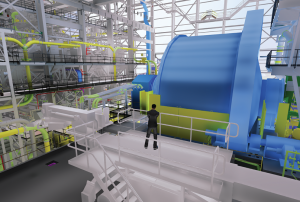How 3-D communication technologies are revolutionizing mining engineering design

Real-time 3-D model presenting Phase II of the Bloom Lake mining complex in Quebec Credit: BBA
Technologies used to convey mining engineering projects have evolved significantly over the past decade. The recent addition of real-time 3-D models and technologies like virtual reality (VR) and augmented reality (AR) provide users with an immersive experience that was previously unattainable. The shift to these new means of communication is both desirable and unavoidable.
More than just visualization devices, these tools can be used for planning, design, risk analysis, communication and social acceptability. Moreover, the realism of the modelled spaces and their immersive effect make them ideal tools for prevention, occupational health and safety training and virtual site visits. Integrating these emerging technologies into project design methods adds value and provides long-term benefits to our mandates. However, certain adjustments to current engineering practices must be made to use these technologies efficiently.
The key to success lies primarily in the form of the content and not in the delivery devices such as VR headsets. 3-D design models, fed by various engineering and design teams, are often the source of the problem. They are usually far too complex to be published using immersion headsets or standard computer equipment. So, geometries must be simplified, without compromising model details and quality. This simplification is meant to speed up real-time visualization, reduce data size and make it easier to interact with 3-D data.
BBA has had the opportunity to develop and employ various 3-D communication tools for mining projects. For example, all project components for Phase II of the Bloom Lake mining complex, owned by Quebec Iron Ore (a subsidiary of Champion Iron), were integrated into a real-time 3-D model. Once lightened using semi-automated processes, the model was used to support preliminary studies, detailed engineering, facility construction and commissioning. As a result, the model evolved throughout the project and design process.
The model was also integrated into a video game interface that allows users to move freely around the plant in virtual mode. As such, employees can become familiar with their future workplaces in a fun way. This interface will serve as a springboard to other interactive products for operational activities, occupational health and safety and operator training.
Today, 3-D communication technologies are considered to be the optimal solution for analyzing configurations for existing or future installations and communicating projects without restrictions. Thanks to a better understanding of the environment, these approaches can have positive effects on the entire community by allowing professionals to improve their design methods, communicate more effectively and make it easier to share information among project stakeholders.
Mathieu Brochu is a geomatics and simulation specialist with BBA.
Comments